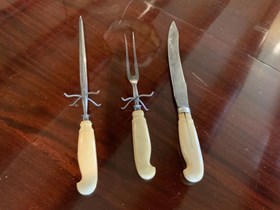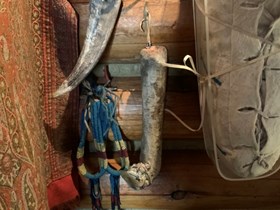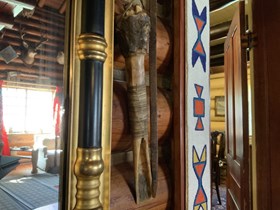Narrow Results By
- Date
- 1870 – 1900
- Material
- skin; quill; glass; hair, horse
- Catalogue Number
- 109.02.0005
- Description
- A long narrow bag with fringe along the bottom edge and a drawstring closing and flap at the top. The bag is completely beaded with a white background and figures of two horses (one white, one dark) with four crosses beaded at the top. The top of the fringe is wrapped with quills, predominently r…
1 image
- Title
- Calumet Bag
- Date
- 1870 – 1900
- Material
- skin; quill; glass; hair, horse
- Dimensions
- 18.0 x 95.0 cm
- Description
- A long narrow bag with fringe along the bottom edge and a drawstring closing and flap at the top. The bag is completely beaded with a white background and figures of two horses (one white, one dark) with four crosses beaded at the top. The top of the fringe is wrapped with quills, predominently red with white and dark zig-zag pattern. The flap is beaded at the end with three hair tassels.
- Subject
- Indigenous, Sioux
- beadwork
- quillwork
- animals, horses
- smoking
- Pat Brewster
- Philip Moore
- ceremonial
- Credit
- Gift of Pearl Evelyn Moore, Banff, 1979
- Catalogue Number
- 109.02.0005
Images
This material is presented as originally created; it may contain outdated cultural descriptions and
potentially offensive content.
Read more.
- Date
- 1875 – 1910
- Material
- metal, steel; ivory
- Catalogue Number
- 104.20.0073 a-c
- Description
- A three piece carving set consisting of a knife (a), a meat fork (b), and a sharpening steel (c). Each piece has an ivory handle shaped with a slight curl to the right at the end. a) The carving knife has a long narrow blade. b) The fork has two long sharp tines and four curved pieces of wire stic…
1 image
- Title
- Carving Set
- Date
- 1875 – 1910
- Material
- metal, steel; ivory
- Dimensions
- 36.5 (a); 28.5 (b); 41.0 (c) cm
- Description
- A three piece carving set consisting of a knife (a), a meat fork (b), and a sharpening steel (c). Each piece has an ivory handle shaped with a slight curl to the right at the end. a) The carving knife has a long narrow blade. b) The fork has two long sharp tines and four curved pieces of wire sticking out in a star shape around the base of the handle.c) The sharpening steel has a long round steel blade with four curved pieces of wire sticking out in a star shape at the base of the handle.
- Subject
- households
- social customs
- animals
- Credit
- Gift of Pearl Evelyn Moore, Banff, 1979
- Catalogue Number
- 104.20.0073 a-c
Images
This material is presented as originally created; it may contain outdated cultural descriptions and
potentially offensive content.
Read more.
- Date
- 1875 – 1920
- Material
- bone, elk; fibre; metal, steel
- Catalogue Number
- 104.24.0001
- Description
- A hide scraper made from the leg bone of an elk, and carved to form a long handle which fits the hand well. There is a short right angle carved at the bottom and split horizontally to hold a rounded steel blade that is sharpened at the edge. The bone is notched and tied firmly with a strip of cot…
1 image
- Title
- Hide Scraper
- Date
- 1875 – 1920
- Material
- bone, elk; fibre; metal, steel
- Dimensions
- 24.0 x 5.5 x 8.0 cm
- Description
- A hide scraper made from the leg bone of an elk, and carved to form a long handle which fits the hand well. There is a short right angle carved at the bottom and split horizontally to hold a rounded steel blade that is sharpened at the edge. The bone is notched and tied firmly with a strip of cotton fabric to secure the blade. A shiny metal hook is attached at the top along with a short loop of thong for hanging.
- Credit
- Gift of Pearl Evelyn Moore, Banff, 1979
- Catalogue Number
- 104.24.0001
Images
This material is presented as originally created; it may contain outdated cultural descriptions and
potentially offensive content.
Read more.
- Date
- 1875 – 1920
- Material
- bone; skin
- Catalogue Number
- 104.24.0002
- Description
- A hide scraper made from the leg bone of a deer or elk, from just below the knee, and carved into a squared shape. The scraper is hollowed and one half of its length is cut away leaving a flattened sharpened serrated end. The animal’s hide is still on the knee joint at the top and there is a han…
1 image
- Title
- Hide Scraper
- Date
- 1875 – 1920
- Material
- bone; skin
- Dimensions
- 38.0 x 6.0 x 6.3 cm
- Description
- A hide scraper made from the leg bone of a deer or elk, from just below the knee, and carved into a squared shape. The scraper is hollowed and one half of its length is cut away leaving a flattened sharpened serrated end. The animal’s hide is still on the knee joint at the top and there is a hanging thong threaded through a drilled hole at the knee. The bone is tightly wrapped with strips of rawhide (or sinew?) one third of its length to hold the two pieces together where the bone was split.
- Subject
- households
- Indigenous
- Stoney
- animals
- elk
- deer
- crafts
- carving
- Credit
- Gift of Pearl Evelyn Moore, Banff, 1979
- Catalogue Number
- 104.24.0002
Images
This material is presented as originally created; it may contain outdated cultural descriptions and
potentially offensive content.
Read more.








